Question
Question 1 1.1 From a project resource management perspective analyse some of the key problems highlighted in the case study and how they could have
Question 1 1.1 From a project resource management perspective analyse some of the key problems highlighted in the case study and how they could have been avoided. (10 marks)
KUSILE, MEDUPI CONCEIVED IN THE 20TH CENTURY, STRUGGLING IN WATER SCARCE 21ST Not far from Johannesburg, set amid the corn and sunflower fields of the Highveld in Mpumalanga province, stand two unusually thick and tall candy-striped smokestacks, dozens of stout concrete support columns, and the tangled steel superstructure of the unfinished 4 800 MW Kusile coal-fired power station. About 370km northwest, spread across a stretch of dry scrubland in Limpopo province, is the construction site for Kusiles unfinished twin, the 4 800 MW Medupi power station. More than a decade ago, at the turn of the 21st century, South Africa conceived the idea of building Kusile and Medupi, two of the four largest coal plants in the world. The proposal gained significant public prominence around the centurys end when South Africas bid to develop its own nuclear reactor design, and build several plants, was rejected by the global finance community. Medupi and Kusile, designed with advanced water conservation cooling and pollution control systems, and due to be completed by 2014 and 2015, respectively, at a cost of $6bn each, were greeted as both momentous and logical. Over the last several years, dawn has evolved into a gathering storm. Long construction delays and escalating costs, engineering challenges, and the intensifying risk of scarce water have pushed Kusile and its sister plant into the eye of a typhoon of economic, ecological, and social disturbances engulfing South Africa. In so many ways, the troubled development of Kusile and Medupi, and the tumult enveloping South Africas deteriorating financial and social condition, are not just mirror images of each other. The two plants, projected to be almost a decade late in completion and $20bn or more over budget, are among the principal causes. The trouble is not simply a matter of managerial missteps. The vortex of disruption that envelops Medupi and Kusile reflects the clash between the economic and ecological operating systems of two centuries. Kusile and Medupi arguably represent the most prominent global examples of big projects that do not fit their time. Conceived in the resource-rich, more ecologically stable, and capital-abundant turn of the century, the two plants were viewed as reasoned answers to South Africas growing demand for electricity, and as evidence of a new governments capacity to execute complex industrial projects. South Africa sees its global reputation as tied to completing the two plants. They must finish and they will finish, said Jacob Misimango, a 54-year-old business executive in Emalahleni who is seeking permits to start an open cast coal mine outside the city, in part to supply fuel for Kusile. These projects have drawn the worlds attention. They have to finish. Why? Number one. There is a shortage of electricity. The only solution is these stations. We have coal to fuel them. Two. Its important for our government to prove we can do this thing. Our national pride is at stake. Not being able to finish is demoralizing. We must prove we can finish. Three. There is a lot of interest on loans that we have to pay back. We need to finish to pay back those loans. 2 Big ideas encounter tumult But well over a decade after they were initially proposed, both plants, and their builder, are crashing into the project-debilitating limits of the resource-scarce, ecologically unstable, and nervous financial markets of the advancing 21st century. Said another way, the narrative of economic progress, expressed by gargantuan industrial projects and centralised management practices, is breaking apart under intense ecological pressure. Medupi and Kusile are examples of large-scale mega infrastructure projects that countries see as the basis of a development model that started after World War II, said Janet Redman, director of the Climate Program at the Institute for Policy Studies in Washington, DC, and an authority on World Bank loan programs. Projects this large are seen as transformational. They cost a lot. They employ a lot of people. Their effects are meant to be big. But its a model that doesnt make much sense now. By now, all of the six steam turbines at the Kusile power station, each capable of generating 800 MW of electricity, were supposed to be operating with water-conserving, air quality-preserving, state of the art fossil fuel-fired efficiency. The anticipated commercial opening of the mammoth plant was to be celebrated as a globally significant statement about a new democracys capacity to think big and prove that an African government can deliver fresh currents of electricity to growing cities and modern industries. Perhaps the original five-year construction schedule was too ambitious. Certainly, the initial estimate of Kusiles completed cost was too hopeful. Yet what greets visitors to the plants construction site on the South African Highveld is a mega energy generation project that is setting new international standards for construction delays, cost increases, design and engineering conflicts, and ecological impediments. Last summer, Eskom formally opened the first 800 MW turbine at Medupi. In February Eskom announced the planned opening of the first 800 MW turbine at Kusile, scheduled in 2014 to open during the summer of 2016, was pushed back to sometime in 2018.
Step by Step Solution
There are 3 Steps involved in it
Step: 1

Get Instant Access to Expert-Tailored Solutions
See step-by-step solutions with expert insights and AI powered tools for academic success
Step: 2

Step: 3

Ace Your Homework with AI
Get the answers you need in no time with our AI-driven, step-by-step assistance
Get Started


